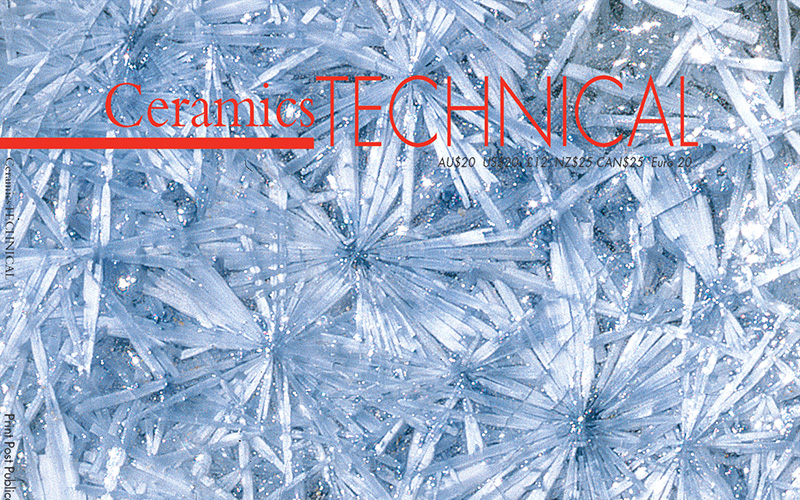Sinuous & Sensual - Leo King finds originality in the sculptural works of Graham Ambrose...
TEN YEARS IS A RELATIVELY SHORT TIME to achieve the high standard of professionalism that is apparent in the work of Graham Ambrose, but perhaps more credible when you understand that during this time he has experienced a wide range of ceramic techniques, including raku, pit firing, wood and anagama firing.
All of which he approached with the same passion that characterises what he makes today. The originality of the latest work, known as Three Quarter Pots; have been creatively conceived from Ambrose’s ability as a designer and achieved by more than usual manual skills.
As a designer, he has the ability to mentally rotate his view of the object he is designing, in much the same way as the rotational capability of a CAT scanner. This gives him the ability to generate complex designs which could otherwise only be achieved painstakingly, by time and by trial, which is, in any case, part of the process. Coupled with this, is his capacity to execute the production of objects with accuracy and precision, which results from his early five-year apprenticeship in furniture making and which he subsequently employed in the manufacture, on a production basis, of New Zealand furniture. However, it was the introduction of Scandinavian design incorporating Bauhaus precepts in the 1950s; its minimalism and use of materials that were traditionally ‘foreign’ to the furniture trade that ‘blew him away’.
For many years Ambrose has been an admirer of the work of both Kanjiro Kawai, and of Jim Greig, a New Zealand potter who spent much time in Japan and while influenced by the culture, created many original forms. The Three Quarter slab built pots of Ambrose have an impressive heritage. Between 60 cm and 75 cm in height, they are made from four slabs, one of which ‘disappears’ as it is terminated in a point at the top, (now formed from three slabs),hence the title of the work. The surfaces which swell and deflate with a curving sinuosity are hand formed with an individuality and complexity which rival those of the interior structures in the foyer of the Guggenheim Art Gallery in Bilbao; the generation of which surfaces could only be achieved by computer control.
While the overall impression is that of the rhythmic twisting movement of an embryonic helix, each side presents a contrasting view and the reference to nature is clear. The side that is terminated in a point may be seen as a raindrop and, looking down on to the triangulated top, it is possible to imagine an exotic bird looking coyly over its shoulder. There is no surface decoration to
distract from the form which is highlighted by the startling white edges which are deliberately sharp to allow the glaze to break. The colour is uniformly red but is allowed to vary between pieces from a sensual blue red to a lighter more frivolous yellow red. He has used commercial red glazes modified to fit the body for much of the work.
This choice was influenced by a Chinese collector who, having received an early example of Ambrose’s work, made the suggestion to him that he should try a red glaze. The symbolism of the colour in the Chinese culture is well known, where Yin and Yang are fundamental forces. The colour red is associated with Yang which is male, light, warmth, activity, life and denotes good fortune and happiness. These forms have been developed over the past few years and with the limitless possibilities that they offer, are likely to form a large part of his aesthetic output.
Despite his predilection for slab building, which affords him creative freedom, he also enjoys the more restricted disciplines of the wheel, from which many of his pots have been made. In particular, a series called Double Walled Pots, which are not containers but sculptural objects. Where one might expect to find a hole at the top of the form it is sealed by an inverted hemisphere, formed during the process of throwing, this simultaneously creates and frustrates the illusion of an internal void. This is the area of interest, where the flat plane, supported as it is by the cylinder that flares outwardly, appears to float, enhancing the architectural nature of the form and bringing to mind that of some Australian water towers. While formal elegance and scale give the Orbs the presence that is required of a decorative object, there is a sensual quality, emphasised by the glowing warmth, apparent softness and mamillated contour that demands to be caressed.
Ambrose’s commitment to ceramics is total, having ‘found’ it in his maturity. His work is contemporary and sympathetic to the current ambience apparent in New Zealand ceramics, where younger potters with increasing levels of ingenuity and imagination, appear to be generating a new wave of public interest after what seemed to be a downturn in the recent past.
Copyright Australian Ceramics Technical No 24. 2007.
Written by Leo King - a writer on the arts from Auckland,NZ.
Download the article - Sinuous and Sensual (PDF 134KB)


